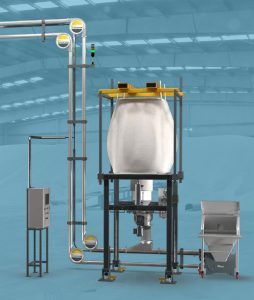When a major NZ cereal maker needed to increase cereal conveying and output on its production line it turned to powder and granule handling specialist Floveyor. Here’s why.
The growing popularity and increased demand for the NZ Cereal maker’s unique breakfast cereals meant an investment in new equipment. Their current processes were not meeting the requirements of conveying grains and fine ingredients with minimal loss and without product degradation or cross-contamination, while also increasing output.
A local New Zealand OEM was consulted regarding a solution to the ongoing ingredient-loading headache, recommending Floveyor, an Australian company specializing in powder and granule handling within the food and beverage industry.
Floveyor is a third-generation family business that designs, manufactures and supports bulk-handling solutions and are the original inventor of the aero-mechanical method of conveying.
The Cereal maker had already an original Floveyor installed on site and was familiar with the basic conveyor, however, they were unaware of the greater portfolio including the variety of equipment and services that Floveyor provides.
Floveyor proposed a solution to facilitate bulk handling of raw ingredients within the current factory layout, while meeting hygiene requirements and eliminating cross contamination.
What were the key elements driving change?
The cereal making business required a system that could load and weigh dry ingredients from a range of sources including bulk bags, small hand tipped bags and plastic bins into a batch mixer, also allowing extra minor supplements to be added.
The company was using several bucket elevators upstream in the process and were having a lot of issues preventing cross contamination of allergens such as nuts and gluten free products.
With over 40 ingredients incorporated into their large cereal product range, the system had to be versatile enough to handle a myriad of powders and granules, many of which were friable in nature.
The current loading process was labour intensive and caused many workplace safety issues. Staff were required to manually lift FIBC’s directly into the mixer via a platform gate and work at heights to load minor ingredients. It involved multiple pallet movements per batch and high forklift traffic.
The Challenge
A system was required that could:
- Elevate the product
- Convey product that is “dust and as fragile as a cornflake, and as stock as sugar dust”.
- Move up to nine ton per hour of product with densities ranging from 130 g/L through to 600 g/L
- Provide cost effective change parts and offline cleaning capability
- Reduce safety hazards such as working at heights, manual bulk handling of FIBCs and forklift movement
Other requirements included:
- A solution that could be integrated with the existing batch mixer, platform and loading area and meet roof clearance restrictions.
- Reduce waste and improve batch consistency by removing human error from the weighing and loading of ingredients.
- Match the ingredient feeding rates to the required batch loading times, without compromising accuracy of blends.
- A design that met hygiene standards and prevented cross contamination of products.
- Prompt ROI
- Capacity for a second machine to be added in the future as demand required.
Getting a grip
Floveyor’s engineers considered several factors as part of the discovery process. The first was to establish site constraints, hazard or clean zoning, vehicle movements, existing equipment, and operator access locations. Knowledge of the process, batch times and the accuracy of the outputs was required as well as cleaning and validation procedures and the current pain points. Research was conducted around of the properties of the raw materials and blends. The final element was to consider any time or commercial constraints.
The solution
The Floveyor AMC was recommended as allergens such as nuts needed to be isolated, and cleanability was paramount.
A F3 Floveyor was specified to match the requirements of low operating costs, minimal particle damage and the ability to handle any variations within the range of ingredients. With upwards of 15,000kg/hr throughputs, utilising a 1.5kW drive, the conveyor was more energy efficient than a pneumatic system. The 76mm system used a vertical then horizontal run to fit into ceiling height restrictions.
A FIBC bulk bag unloader allowed bags to be loaded with a forklift and placed into the support frame. Bag massaging paddles promoted material flow and minimised residue in the empty FIBCs.
To manage the variable batch needs and differing ingredient weights, the FIBC unloader was supplied with load cells for a loss-in-weight system. These were paired with a short 150mm-diameter dosing screw feeder that allowed controlled feeding of ingredients into the Floveyor AMC within 1% accuracy.
A touchscreen HMI mounted control panel was installed, providing an easy set up and simple recipe selection prompt screen for consistently accurate ingredient ratios. A visual light tower alerts operators to FIBC replacing.
A station was set at ground level where manual tipping of minor additives could be performed, based on pre-weighed containers. This process is independent of the loss-in-weight system. Due to the high conveying capacity of the Floveyor AMC both minor ingredients and loss-in-weight ingredients are able to be added at the same time.
Delivery and Installation
The system was fully tested off-site, then flat packed for modular export transport. All resources were supplied to allow the customer to install, commission or maintain its new equipment independently without requirements for proprietary knowledge. The client was impressed by the depth and quality of the documentation from electrical drawings to the installation instructions and user manuals.
Objectives achieved
All objectives were achieved. The F3 Floveyor provided a safe, efficient method of transporting the fine, varied ingredients in consistent and accurate proportions and without contamination. An added benefit to the company was a reduced workforce requirement.
The Floveyor’s simple hygienic design was described as ‘awesome’ and very well suited to processing cereal ingredients. The replacement of the bucket elevators with the Floveyor led to excellent ROI and less cleaning required.


